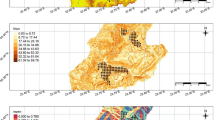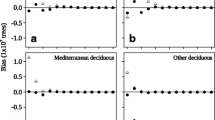Abstract
A transition matrix growth and an ingrowth model were developed and applied to an uneven-aged mixed-species forest in the Changbai Mountains, northeastern of China. Results indicate that the constant-parameter transition probabilities for all species in the mixed uneven-aged forest could be classified into three groups based on the mean upgrowth probabilities of each species. Constant-parameter transition probabilities of all species in each diameter class fluctuate within a narrow range except for diameter classes below 8 cm and greater than 60 cm. Variable-parameter transition probabilities were found to be a function of residual basal area for small diameter classes. For large trees, transition probabilities are not affected by the residual basal area. Based on this study, variable-parameter transition probabilities for large diameter trees can be replaced with constant-parameter transition probabilities. In addition, a new ingrowth model was developed and the new ingrowth model was shown to perform better than existing ingrowth model used in the region.
Similar content being viewed by others
References
D.M. Adams A.R. Ek (1974) ArticleTitleOptimizing the management of uneven-aged forest stands Can. J. For. Res. 4 274–287
H.D. Bruner J.W. Moser SuffixJr. (1973) ArticleTitleA Markov chain approach to the prediction of diameter distributions in uneven-aged forest stands Can. J. For. Res. 3 409–417
S.H., Bullard H.D. Sherali W.D. Klemperer (1985) ArticleTitleEstimating optimal thinning and rotation for mixed-species timber stands using a random search algorithm For. Sci. 31 IssueID(2) 303–315
J. Buongiorno B.R. Michie (1980) ArticleTitleA matrix model of uneven-aged forest management For. Sci. 26 609–625
J. Buongiorno J. Peyron F. Houllier M. Bruciamacchie (1995) ArticleTitleGrowth and management of mixed-species, uneven-aged forests in the French Jura: implications for economic returns and tree diversity For. Sci. 41 IssueID(3) 397–429
Cassell R.F. and Moser Jr. J.W. 1974. A programmed Markov model for predicting diameter distributions in uneven-aged forests. Purdue Univ. Agric. Exp. Stat. Res. Bull. 915, pp. 43.
Chinese Surveying and Planning Institute. 1981. Mountain Forest of China. Forestry publish house of China.
W.G. Doubleday (1975) ArticleTitleHarvesting in matrix population models Biometrics 31 189–200
A.R. Ek (1974) ArticleTitleNonlinear models for stand table projection in northern hardwood stands Can. J. For. Res. 4 23–27
J.R. Frazier (1978) An investigation of the Markov model to predict individual tree DBH. M.S. Thesis Auburn University Auburn
J.H. Gove S.E. Fairweather (1992) ArticleTitleOptimizing the management of uneven-aged forest stands: a stochastic approach For. Sci. 38 623–640
Hann D.W. and Bare B.B. 1979. Uneven-aged forest management: state of the art. USDA For. Serv. Gen. Tech. Rep. INT-50, pp. 18.
Institute of forestry soil of China. 1978. Korean Pine Forest. Academy of forestry Science, Agricultural publish house of China.
J.P. Kimmins (1990) ArticleTitleModeling the sustainability of forest production and yield for a changing and uncertain future For. Chron. 66 271–280
J.P. Kimmins (1997) Forest Ecology: A Foundation for Sustainable Management. 2nd edn Prentice Hall New Jersey
P.H. Leslie (1945) ArticleTitleOn the use of matrices in certain population mathematics Biometrika 33 183–212
E.G. Lewis (1942) ArticleTitleOh the generation and growth of a population Sankhya 6 93–96
C.R. Lin J. Buongiorno (1997) ArticleTitleFixed versus variable-parameter matrix models of forest growth: the case of maple-birch forests Ecol. Model. 99 263–274 Occurrence Handle10.1016/S0304-3800(97)01960-1
C.-R. Lin J. Buongiorno M. Vasievich (1996) ArticleTitleA multi-species, density-dependent matrix growth model to predict tree diversity and income in northern hardwood stands Ecol. Model. 91 193–211 Occurrence Handle10.1016/0304-3800(95)00190-5
H. Lu J. Buongiorno (1993) ArticleTitleLong- and short-term effects of alternative cutting regimes on economic returns and ecological diversity in mixed-species forests For. Ecol Manage. 58 173–192
G.A. Mendoza A. Setyarso (1986) ArticleTitleA transition matrix forest growth model for evaluating alternative harvesting schemes in Indonesia For. Ecol. Manage. 15 219–228
D.L. Mengel J.R. Roise (1990) ArticleTitleA diameter-class model for southeastern U.S. coastal plain hardwood stands South. J. Appl. For. 14 189–195
J.W. Moser SuffixJr. (1972) ArticleTitleVariable-parameters of an uneven-aged forest stands For. Sci. 18 184–191
Moser Jr. J.W. 1974. A system of equation for the components of forest growth. In: Fies J. (eds), Growth Models for Tree and Stand Simulation. Res. Notes 30, Royal. Coll. For., Stockholm, pp. 260–287.
J.W. Moser SuffixJr. O.F. Hall (1969) ArticleTitleDeriving growth and yield functions for uneven-aged forest stands For. Sci. 15 183–188
Murphy P.A. and Farrar R.M. 1985. Growth and yield of uneven-aged shortleaf pine stands in Interior Highlands. USDA For. Serv. Res. Pap. SO-218, pp. 11.
M.R. Roberts A.J. Hruska (1986) ArticleTitlePredicting diameter distributions: a test of the stationary Markov model Can. J. For. Res. 16 130–135
C. Rorres (1978) ArticleTitleA linear programming approach to the optimum sustainable harvesting of a forest J. Environ. Manage. 6 245–254
S. Sanchez Orois R. Soalleiro Rodriguez (2002) ArticleTitleModelling the growth and management of mixed uneven-aged Maritime Pine- broadleaved species forest in Galicianorth-western Spain Scand. J. For. Res. 17 538–547 Occurrence Handle10.1080/02827580260417198
B.J. Schulte J. Buongiorno (1998) ArticleTitleEffects of uneven-aged silviculture on the stand structurespecies composition, and economic returns of loblolly pine stands For. Ecol. Mange. 111 83–101
D.S. Solomon R.A. Hosmer H.T. Hayslett (1986) ArticleTitleA two-stage matrix model for predicting growth of forest stands in northeast Can. J. For. Res. 16 521–528
M.B. Usher (1966) ArticleTitleA matrix approach to the management of renewable resources, with special reference to selection forests J. Appl. Ecol. 3 355–367
M.B. Usher (1976) ArticleTitleExtensions to models, used in renewable resource managementwhich incorporate an arbitrary structure J. Environ. Manage. 4 123–140
V.C. Volin J. Buongiorno (1996) ArticleTitleEffects of alternative management regimes on forest stand structurespecies composition, and income: a model for the Italian Dolomites For. Ecol. Manage. 87 107–125
Author information
Authors and Affiliations
Corresponding author
Rights and permissions
About this article
Cite this article
Hao, Q., Meng, F., Zhou, Y. et al. A transition matrix growth model for uneven-aged mixed-species forests in the Changbai Mountains, northeastern China. New Forest 29, 221–231 (2005). https://doi.org/10.1007/s11056-005-5657-z
Received:
Accepted:
Issue Date:
DOI: https://doi.org/10.1007/s11056-005-5657-z




